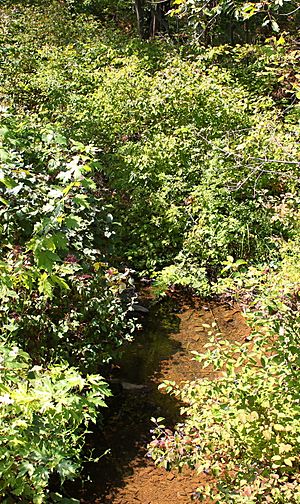Lick Creek (Shamokin Creek tributary) facts for kids
Quick facts for kids Lick Creek |
|
|---|---|

Lick Creek looking upstream
|
|
| Physical characteristics | |
| Main source | valley on a ridge in Shamokin Township, Northumberland County, Pennsylvania between 960 and 980 feet (290 and 300 m) |
| River mouth | Shamokin Creek in Shamokin Township, Northumberland County, Pennsylvania 545 ft (166 m) 40°50′58″N 76°35′14″W / 40.84945°N 76.58714°W |
| Length | 2.7 mi (4.3 km) |
| Basin features | |
| Progression | Shamokin Creek → Susquehanna River → Chesapeake Bay |
| Basin size | 2.46 sq mi (6.4 km2) |
| Tributaries |
|
Lick Creek is a small stream, or tributary, that flows into Shamokin Creek in Northumberland County, Pennsylvania. It's about 2.7 miles (4.3 km) long, which is like walking a little over two and a half miles! The creek flows through a place called Shamokin Township.
The area of land that drains water into Lick Creek, called its watershed, covers about 2.46 square miles (6.4 km2). This creek is known for its clean water and is a good home for many water creatures, including fish.
Contents
The Journey of Lick Creek
Lick Creek starts its journey in a valley located on a ridge in Shamokin Township. Imagine it beginning high up in the hills!
First, it flows towards the east-northeast for a short distance. Then, it turns north and gets water from a smaller stream that joins it from the right side. The creek continues flowing north for a bit more, entering a wider valley. Here, another small stream joins it from the left side.
Next, Lick Creek turns east and flows for over a mile. Along this stretch, two more small streams add their water to the creek from the left. After that, it turns north-northeast, then east again. Finally, it turns northeast for a short distance and flows under Pennsylvania Route 61. Soon after, it meets and joins Shamokin Creek.
Lick Creek joins Shamokin Creek about 16.03 miles (25.80 km) before Shamokin Creek reaches its own end.
Smaller Streams Joining Lick Creek
Lick Creek doesn't have any big, named streams flowing into it. However, it does have several smaller, unnamed streams that add water to it. Some of these smaller streams are "intermittent," which means they only flow with water during certain times of the year, like after it rains or when snow melts.
Water, Land, and Rocks
The place where Lick Creek joins Shamokin Creek is about 545 feet (166 m) above sea level. Where Lick Creek begins, its source is much higher, between 960 and 980 feet (290 and 300 m) above sea level. This shows how the water flows downhill!
It's great news that Lick Creek is not affected by mining activities, which often cause pollution. This means the creek has very clean water. All the streams in the Lick Creek watershed are healthy and safe, meaning they are good for their purpose, like supporting plants and animals.
The Lick Creek Watershed
The watershed of Lick Creek is the entire area of land where all the rain and melted snow eventually flow into Lick Creek. This area covers about 2.46 square miles (6.4 km2).
The mouth of Lick Creek (where it ends) is shown on a special map called the United States Geological Survey quadrangle of Shamokin. But the source of the creek (where it begins) is on a different map called the quadrangle of Trevorton. The Lick Creek watershed is located in the lower part of the larger Shamokin Creek watershed.
History of the Creek's Name
Lick Creek was officially added to the Geographic Names Information System on August 2, 1979. This system helps keep track of names for places like rivers and mountains. Its special ID number in that system is 1179280.
Water Creatures and Fish
The area around Lick Creek is special because it's known as a Coldwater Fishery and a Migratory Fishery. A "Coldwater Fishery" means the water is cold enough for certain types of fish that like chilly temperatures. A "Migratory Fishery" means that fish travel through this creek as part of their life journey.
There are many different kinds of water creatures living in Lick Creek today. In the past, the creek was known for having a very healthy and diverse group of water animals and plants, making it a lively aquatic community.


